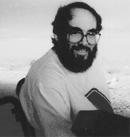What Happened To Architectural Accessibility?
by: Steven E. Brown, Fall 1998

![]() As the founder of Institute on Disability Culture (IDC), Steven E. Brown earned a doctorate in history from the University of Oklahoma. He directed an independent living center in Oklahoma, organized numerous community coalitions, and served as a Training Director at the World Institute on Disability. He founded the not-for-profit Institute on Disability Culture, with his wife Lillian Gonzales Brown, in 1994. Since then he has become an internationally sought speaker, trainer, and writer.
As the founder of Institute on Disability Culture (IDC), Steven E. Brown earned a doctorate in history from the University of Oklahoma. He directed an independent living center in Oklahoma, organized numerous community coalitions, and served as a Training Director at the World Institute on Disability. He founded the not-for-profit Institute on Disability Culture, with his wife Lillian Gonzales Brown, in 1994. Since then he has become an internationally sought speaker, trainer, and writer.
When I first became involved in the disability rights movement in the U.S. in the early 1980s, independent living centers were sometimes criticized for catering to the needs of people with mobility impairments, especially those who used wheelchairs. There was some truth to this allegation. After all, it seemed that across the U.S. facilities and services and organizations already existed for those who were deaf or blind or had a developmental disability. If you were a wheelchair user where did you go to find service on a grassroots level? Until CILs came along, nowhere.
The corollary to this accusation was that accessibilty focused on architectural accessibility at the expense sometimes of other kinds of accessibility, such as alternative formats and sign language interpeting. In fact, sometimes architectural accessibility obtained the tag of being easy. How hard could it be, people wondered, to understand that a building needed a ramp or an elevator? Anyone could see, if they just looked, that a lift on a bus would benefit a wheelchair rider. It seemed much harder to convince people that braille or large print formats constituted a reasonable accommodation. Deaf individuals sometimes became so frustrated with CILs and other organizations designed to serve people with disabilities that they stayed away from them. Together they could communicate with one another. Even when interpreters were provided for meetings, they were rarely contracted for the social time of any meeting agenda.
So, what happened?
Why is it that when I go out in my power wheelchair and my big wheelchair lift- equipped van, I am always conscious of the possibility that I won't find a parking space that will meet my needs or a ramp to the building I wish to enter or an elevator to take me to another story?
The Architectural Barriers Act of 1968 predates both the Rehabilitation Act, as we know it today, and the Americans with Disabilities Act. Why is this so-called easy aspect of accessibility still so difficult to locate in more than a few places?
I had an opportunity to be in Germany about a year ago. I spoke with a wheelchair user there who sang the praises of accessibility in America. He'd even been able to go down into Carlsbad Caverns, in my home state of New Mexico, an experience he had no expectation of being able to accomplish. When the discussion switched to his own homeland, however, his views more closely matched my perceptions of the U. S.
In one way architectural access was easy. It's easy to see what needs to be done. The catch is doing it. There is no way that anyone can argue that accessibility today is not much greater than it was twenty or thirty years ago, when the modern disability rights movement began. But it is also increasingly more difficult to argue that we have accomplished all that needs to be done. Sidewalks leading to curbs without cuts still abound. Buildings are still being constructed without ramps or curb cuts or accessible parking spaces. People who don't need them still park in handicapped parking spots.
What happened to architectural acessibility?
The easy parts, I think, are being taken into account. Now we must confront harder issues. The sidewalks and buildings and parking lots that were built before any of these accessbility needs were considered by anyone. The cities that were built long ago and whose centers are not only architectually inaccessible, but whose infrastructure is also often disintegrating.
In short, there's just too much to do.
But that still begs the question, why aren't more people talking about and taking action to increase architectural accessibility. I don't have a good answer. You?
Steven E. Brown
2260 Sunrise Point Rd.
Las Cruces, NM 88011
USA
505-522 5225 (Voice/FAX/TDD)
sebrown@hawaii.edu and http://www.dimenet.com/disculture/
Promoting Disability Pride
About Steven E. Brown
As the founder of Institute on Disability Culture (IDC), he earned a doctorate in history from the University of Oklahoma. He directed an independent living center in Oklahoma, organized numerous community coalitions, and served as a Training Director at the World Institute on Disability. He founded the not-for-profit Institute on Disability Culture, with his wife Lillian Gonzales Brown, in 1994. Since then he has become an internationally sought speaker, trainer, and writer.
Brown's publications have been translated into several languages. They Include Independent Living: Theory and Practice, and Investigating a Culture of Disability: Final Report, the result of a prestigious Switzer Fellowship from the National Institute on Disability Rehabilitation and Research of the Department of Education, the first funding of its type for research into the field of Disability Culture; A Celebration of Diversity: An Annotated Bibliography About Disability Culture; and two books of poetry, Pain, Plain--and Fancy Rappings: Poetry From the Disability Culture and Voyages: Life Journeys, a monthly online newsletter, the manifesto, and numerous articles.

